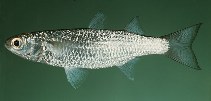| Family: |
Mugilidae (Mullets) |
| Max. size: |
47.7 cm FL (male/unsexed) |
| Environment: |
reef-associated; brackish; marine; depth range 0 - 3 m |
| Distribution: |
Indo-Pacific: East Africa to the Marquesan and Tuamoto islands, north to the Yaeyamas. At least one country reports adverse ecological impact after introduction. |
| Diagnosis: |
Dorsal spines (total): 4-4; Dorsal soft rays (total): 9-10; Anal spines: 3-3; Anal soft rays: 8-9. Olive dorsally; flanks and abdomen silvery; fins hyaline (Ref. 9812). Pectoral fins with dark spot dorsally at origin (Ref. 9812). |
| Biology: |
Inhabit shallow protected sandy to muddy areas of reef flats and shallow lagoons while juveniles have been encountered in tide pools (Ref. 205). Benthopelagic (Ref. 58302). Oviparous, eggs are pelagic and non-adhesive (Ref. 205). Marketed fresh and used as live bait in pole-and-line fishing for tuna (Ref. 9812). |
| IUCN Red List Status: |
Least Concern (LC); Date assessed: 02 July 2016 Ref. (130435)
|
| Threat to humans: |
potential pest |
Source and more info: www.fishbase.org. For personal, classroom, and other internal use only. Not for publication.
